View in other NatureServe Network Field Guides
NatureServe
Montana
Utah
Wyoming
Idaho
Wisconsin
British Columbia
South Carolina
Yukon
California
New York
Marsh Grass-of-Parnassus - Parnassia palustris
Native Species
Global Rank:
G5
State Rank:
S4
(see State Rank Reason below)
C-value:
4
Agency Status
USFWS:
USFS:
BLM:
External Links
State Rank Reason (see State Rank above)
Parnassia palustris occurs in the western and very northeastern portions of Montana. It grows in a variety of wetland and riparian habitats and conditions ranging from fens, wet meadows, seeps, streambanks, and roadside drainages to canals. Population sizes range from being rare and scattered to common though this plant may go unnoticed due to its stature. However, half of the locations were observed prior to 1970. Most of the locations in the southeast and all locations in the northeast were observed prior to 1970. Current data on distribution, population, and threats is greatly needed, paricularly in southwest and northeast Montana.
- Details on Status Ranking and Review
Range Extent
ScoreG - 200,000-2,500,000 sq km (~80,000-1,000,000 sq mi)
Area of Occupancy
ScoreE - 26-125 4-km2 grid cells
Number of Populations
ScoreD - 81 - 300
Environmental Specificity
ScoreB - Narrow. Specialist or community with key requirements common
Threats
ScoreD - Low
CommentNo known threats.
General Description
PLANTS: Stems mostly solitary, 10–35 cm with 1, mostly cordate-clasping bract.
LEAVES: Basal leaves 8-15 mm long, in rosettes (Lesica et al. 2012; FNA 2016). Leaf shape ovate to reniform with truncate to cordate bases (Lescia et al. 2012).
INFLORESCENCE: Terminal with solitary flowers (FNA 2016). Calyx lobes 5–9 mm long; petals oblong, 8–12 mm long with 7 to 9 veins; staminodia obovate with 5 to 7 capitate lobes. Capsule 7–12 mm long (Lesica et al. 2012).
Phenology
Flowering in summer (FNA 2016).
Diagnostic Characteristics
Within North America several variants have been recognized and sometimes treated as distinct species (FNA 2016). In the Rocky Mountains and some adjacent ranges the variety montanensis has been recognized as a species (P. montanensis) because it exhibits petals of 7-9 mm by 5-7 mm and staminodes with 7-10 filaments. These characteristics are somewhat intermediate between P. Palustris and P. parviflora and it has been suggested they could be of hybrid origin (Hitchcock, Cronquist, Owenby, and Thompson 1955-1969, Vascular Plants of the Pacific Northwest, Parts 1-5). However, in northern Asia a similar variant occurs but in the absence of P. parviflora. Therefore, our plant in Montana is maintained as a variant of Parnassia palustris until further studies are done.
Species Range
Montana Range
Range Descriptions
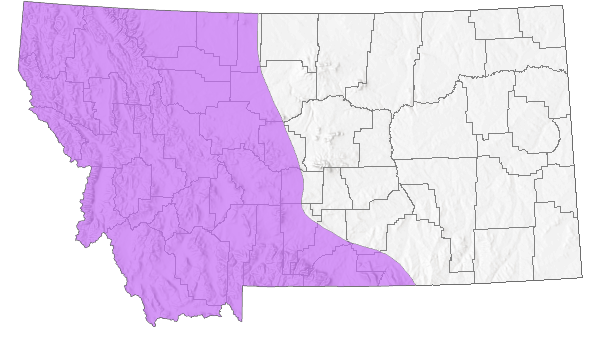
 Native
Native
Range Comments
Circumboreal south to CA, UT, CO, ND and MN (Lesica et al. 2012).
Observations in Montana Natural Heritage Program Database
Number of Observations: 115
(Click on the following maps and charts to see full sized version)
Map Help and Descriptions
Relative Density
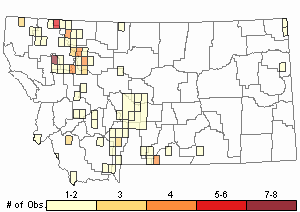
Recency
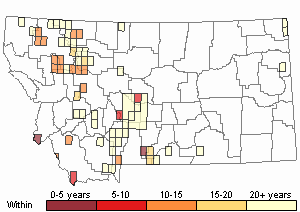

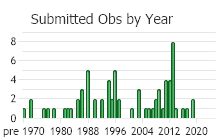
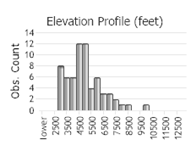 (Observations spanning multiple months or years are excluded from time charts)
(Observations spanning multiple months or years are excluded from time charts)
Habitat
Fens, wet meadows, thickets,and often growing in moss (Lesica et al. 2012).
Stewardship Responsibility
References
- Literature Cited AboveLegend:
 View Online Publication
View Online Publication Flora of North America Editorial Committee, eds. 2016. Flora of North America north of Mexico, Vol. 12. Magnoliophyta: Vitaceae to Garryaceae. Oxford University Press, Inc. New York.
Flora of North America Editorial Committee, eds. 2016. Flora of North America north of Mexico, Vol. 12. Magnoliophyta: Vitaceae to Garryaceae. Oxford University Press, Inc. New York. Lesica, P., M.T. Lavin, and P.F. Stickney. 2012. Manual of Montana Vascular Plants. Fort Worth, TX: BRIT Press. viii + 771 p.
Lesica, P., M.T. Lavin, and P.F. Stickney. 2012. Manual of Montana Vascular Plants. Fort Worth, TX: BRIT Press. viii + 771 p.
- Additional ReferencesLegend:
 View Online Publication
View Online Publication
Do you know of a citation we're missing? Adhikari, S. 2018. Impacts of dryland farming systems on biodiversity, plant-insect interactions, and ecosystem services. Ph.D. Dissertation. Bozeman, MT: Montana State University. 207 p.
Adhikari, S. 2018. Impacts of dryland farming systems on biodiversity, plant-insect interactions, and ecosystem services. Ph.D. Dissertation. Bozeman, MT: Montana State University. 207 p. Hitchcock, C. L., A. Cronquist, M. Ownbey, and J. W. Thompson. 1961. Vascular Plants of the Pacific Northwest, Part 3. Saxifragaceae to Ericaceae. Seattle, WA and London, England: University of Washington. 614 pp.
Hitchcock, C. L., A. Cronquist, M. Ownbey, and J. W. Thompson. 1961. Vascular Plants of the Pacific Northwest, Part 3. Saxifragaceae to Ericaceae. Seattle, WA and London, England: University of Washington. 614 pp. Jones, W. W. 1901. Preliminary flora of Gallatin County. M.S. Thesis. Bozeman, MT: Montana State College. 78 pp.
Jones, W. W. 1901. Preliminary flora of Gallatin County. M.S. Thesis. Bozeman, MT: Montana State College. 78 pp. Lesica, P., M.T. Lavin, and P.F. Stickney. 2022. Manual of Montana Vascular Plants, Second Edition. Fort Worth, TX: BRIT Press. viii + 779 p.
Lesica, P., M.T. Lavin, and P.F. Stickney. 2022. Manual of Montana Vascular Plants, Second Edition. Fort Worth, TX: BRIT Press. viii + 779 p. Tuinstra, K. E. 1967. Vegetation of the floodplains and first terraces of Rock Creek near Red Lodge, Montana. Ph.D dissertation. Montana State University, Bozeman 110 pp.
Tuinstra, K. E. 1967. Vegetation of the floodplains and first terraces of Rock Creek near Red Lodge, Montana. Ph.D dissertation. Montana State University, Bozeman 110 pp. Williams, K.L. 2012. Classification of the grasslands, shrublands, woodlands, forests and alpine vegetation associations of the Custer National Forest portion of the Beartooth Mountains in southcentral Montana. M.Sc. Thesis. Bozeman, MT: Montana State University. 376 p.
Williams, K.L. 2012. Classification of the grasslands, shrublands, woodlands, forests and alpine vegetation associations of the Custer National Forest portion of the Beartooth Mountains in southcentral Montana. M.Sc. Thesis. Bozeman, MT: Montana State University. 376 p.
- Web Search Engines for Articles on "Marsh Grass-of-Parnassus"





